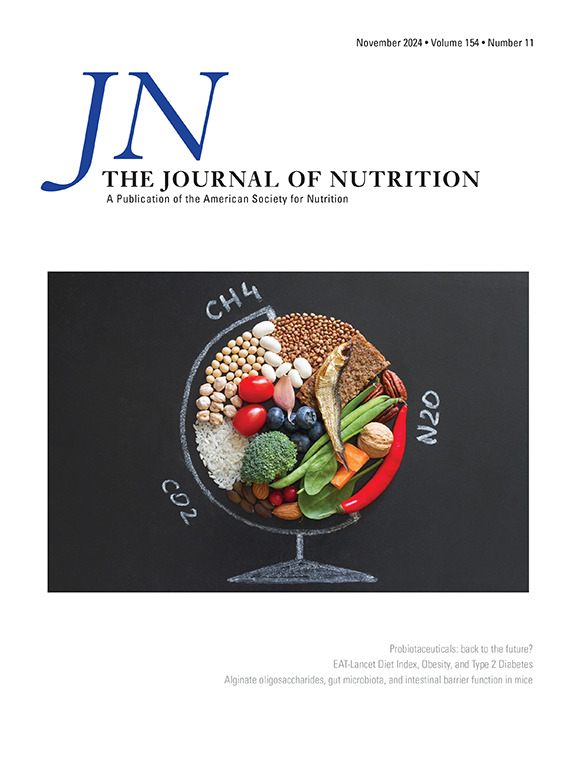Identification and Replication of Urine Metabolites Associated With Short-Term and Habitual Intake of Sweet and Fatty Snacks in European Children and Adolescents
IF 3.7
3区 医学
Q2 NUTRITION & DIETETICS
引用次数: 0
Abstract
Background
Intake of sweet and fatty snacks may partly contribute to the occurrence of obesity and other health conditions in childhood. Traditional dietary assessment methods may be limited in accurately assessing the intake of sweet and fatty snacks in children. Metabolite biomarkers may aid the objective assessment of children’s food intake and support establishing diet–disease relationships.
Objectives
The present study aimed to identify biomarkers of sweet and fatty snack intake in 2 independent cohorts of European children.
Methods
We used data from the IDEFICS/I.Family cohort from baseline (2007/2008) and 2 follow-up examination waves (2009/2010 and 2013/2014). In total, 1788 urine samples from 599 children were analyzed for untargeted metabolomics using high-resolution liquid chromatography-mass spectrometry. Short-term dietary intake was assessed by 24-h dietary recalls, and habitual dietary intake was calculated with the National Cancer Institute method. Data from the Dortmund Nutritional and Anthropometric Longitudinal Designed (DONALD) cohort of 24-h urine samples (n = 567) and 3-d weighted dietary records were used for external replication of results. Multivariate modeling with unbiased variable selection in R algorithms and linear mixed models were used to identify novel biomarkers. Metabolite features significantly associated with dietary intake were then annotated.
Results
In total, 66 metabolites were discovered and found to be statistically significant for chocolate candy; cakes, puddings, and cookies; candy and sweets; ice cream; and crisps. Most of the features (n = 62) could not be annotated. Short-term and habitual chocolate intake were positively associated with theobromine, xanthosine, and cyclo(L-prolyl-L-valyl). These results were replicated in the DONALD cohort. Short-term candy and sweet intake was negatively associated with octenoylcarnitine.
Conclusions
Of the potential metabolite biomarkers of sweet and fatty snacks in children, 3 biomarkers of chocolate intake, namely theobromine, xanthosine, and cyclo(L-prolyl-L-valyl), are externally replicated. However, these potential biomarkers require further validation in children.
鉴定并复制欧洲儿童和青少年与短期和习惯性摄入甜食和油腻零食有关的尿液代谢物。
背景:儿童摄入甜食和油腻零食可能是导致肥胖和其他健康问题的部分原因。传统的膳食评估方法在准确评估儿童甜食和油腻零食的摄入量方面可能存在局限性。代谢物生物标志物可帮助客观评估儿童的食物摄入量,并有助于建立饮食与疾病之间的关系:本研究旨在确定两个独立的欧洲儿童队列中甜食和油腻零食摄入量的生物标志物:我们使用了IDEFICS/I.Family队列中基线(2007/2008年)和两次随访检查(2009/2010年和2013/2014年)的数据。我们使用高分辨率液相色谱-质谱联用技术对599名儿童的1788份尿液样本进行了非靶向代谢组学分析。短期膳食摄入量通过 24 小时膳食回忆进行评估,习惯性膳食摄入量则采用美国国家癌症研究所的方法进行计算。来自 DONALD 队列的 24 小时尿样数据(n=567)和 3 天加权膳食记录用于外部结果的复制。使用 R 中无偏变量选择算法(MUVR)和线性混合模型建立多变量模型,以确定新的生物标志物。然后注释了与膳食摄入量明显相关的代谢物特征:结果:总共发现了 66 个代谢物,并发现它们对 "巧克力糖"、"蛋糕、布丁和饼干"、"糖果和甜食"、"冰淇淋 "和 "薯片 "具有统计学意义。大多数特征(n=62)无法注释。短期和习惯性巧克力摄入量与可可碱、黄嘌呤核苷和环(L-脯氨酰-L-缬氨酰)呈正相关。这些结果在 DONALD 队列中得到了验证。短期 "糖果和甜食 "摄入量与辛烯酰卡尼汀呈负相关:我们确定了儿童甜食和脂肪零食的潜在代谢物生物标志物,其中巧克力摄入量的三个生物标志物,即可可碱、黄嘌呤核苷和环(L-脯氨酰-L-缬氨酰)得到了外部复制。不过,这些潜在的生物标志物还需要在儿童中进一步验证。
本文章由计算机程序翻译,如有差异,请以英文原文为准。
求助全文
约1分钟内获得全文
求助全文
来源期刊

Journal of Nutrition
医学-营养学
CiteScore
7.60
自引率
4.80%
发文量
260
审稿时长
39 days
期刊介绍:
The Journal of Nutrition (JN/J Nutr) publishes peer-reviewed original research papers covering all aspects of experimental nutrition in humans and other animal species; special articles such as reviews and biographies of prominent nutrition scientists; and issues, opinions, and commentaries on controversial issues in nutrition. Supplements are frequently published to provide extended discussion of topics of special interest.
 求助内容:
求助内容: 应助结果提醒方式:
应助结果提醒方式:


